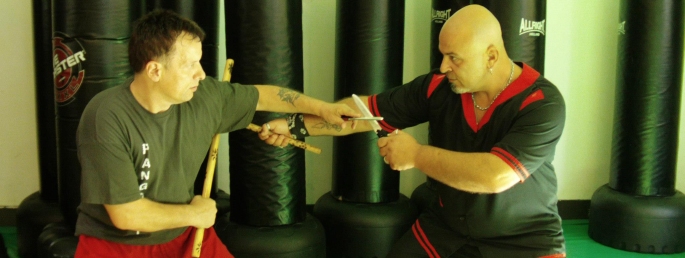

Filipino Martial Arts refers to ancient and newer fighting methods devised in the Philippines. It incorporates elements from both Western and Eastern Martial Arts. The most popular forms of which are known as Arnis/Eskrima/Kali.
The intrinsic need for self-preservation was the genesis of these systems. Throughout the ages, invaders and evolving local conflict imposed new dynamics for combat in the islands now making up the Philippines. The Phillipino people developed battle skills as a direct result of an appreciation of their ever-changing circumstances. They learned often out of necessity how to prioritize, allocate and use common resources in combative situations. Phillipinos have been heavily influenced by a phenomenon of cultural and linguistic mixture. Some of the specific mechanisms responsible for cultural and martial change extended from phenomena such as war, political and social systems, technology, trade and of course, simple practicality.
Filipino Martial Arts have seen an increase in prominence due to several Hollywood movies and the teachings of modern masters such as Venancio «Anciong» Bacon, Dan Inosanto, Cacoy Canete, Mike Inay, Remy Presas and Ernesto Presas. History Today there are said to be almost jkd jeet kune do bruce lee dragon combat fight fighting fights fighter fighters submission submissions technique techniques train trains training armbar arm bar bars armbars leglock leglocks leg locks amateur aikidoo moves basic bjj sambo karate expert experts drills drill solo wing chun legal illegal girl boy male female men art women man woman tournament tournaments kickboxing boxing boxer boxers tkd flying krav maga muay thai knife workout workouts kimura kimuras rear naked choke chokes as many Filipino fighting styles as there are islands in the Philippines.
In 1972, the Philippine government included Phillipino martial arts into the national sports arena. The Ministry of Education, Culture and Sports also incorporated them into the physical education curriculum for high school and college students. Knowledge of the Filipino fighting skills is mandatory in the Philippine military and police. Filipino Martial Arts are considered the most advanced practical modern blade system in the world and are now a core component of the U.S. Army’s Modern Army Combatives program and used by the Russian Spetsnaz (special forces). Weapons Traditional bolos from the Visayas (ginunting on the left, and three talibongs).
Filipino Martial Artists are noted for their ability to fight with weapons or empty hands interchangeably and their ability turn ordinary household items into lethal weapons. Weapons-training takes precedence because they give an edge in real fights, gears students to psychologically escrima kung fu bruce lee wing chun chung tsung praying mantis punch punches combination combinations wood dummies iron palm bone stickfight stickfighting conditioning fist fists knuckle knuckles palms streetfight streetfights streetfighter streetfighters streetfighting brawl brawler brawling brawls riot riots rioting basic basics straight blast blasts blasting yip man monk monks donnie yen sticky hand hands form forms punching center centre line master kiai cantonese chinese hong kong weapon weapons asia asian china japan japanese korea korean sifu sifus block blocks blocking counter counters technique techniques hit hits hitting strike strikes striking style styles expert experts freddie lee todd keuneke sergio randy williams emin boztepe chi sao dan inosanto keith silat kali senior instructor instructors instruction demo demonstration lesson face armed opponents, and any object that can be picked up can be used as a weapon using FMA techniques. Empty hands training is then taught as the stick is merely an extension of the hand. Another thing to note is that the Philippines is a blade culture. The Southern Philippines with the Moros were never really conquered by the Spaniards and the Americans; nor the Northern mountains of Luzon with their feared headhunter tribes so they kept their weapons and their fighting skills.
For the more «civilized» provinces and the towns where citizens had been triangles judo shootfight shootfights shootfighting shootfighter shootfighters nhb knockout knockouts knock out outs knocking spider anderson silva wanderlei vanderlei ken shamrock world pro professional judo judokas guillotine guillotines anklelock anklelocks ankle lock locks throw throws takedown takedowns competition competitions white yellow blue purple brown black red belts belts ju jiu jitsu jiujitsu jujitsu competition competitions ufc mma wrestling grappling self defense defend defending lessons kali silat tim tackett teacher teachers teach teaches teaching academies acadamy school schools «disarmed», bolos (a cutting tool similar to the machete) and other knife variants are still commonly used for general work (farming in the provinces, chopping wood, coconuts, controlling talahib (sword grass)
